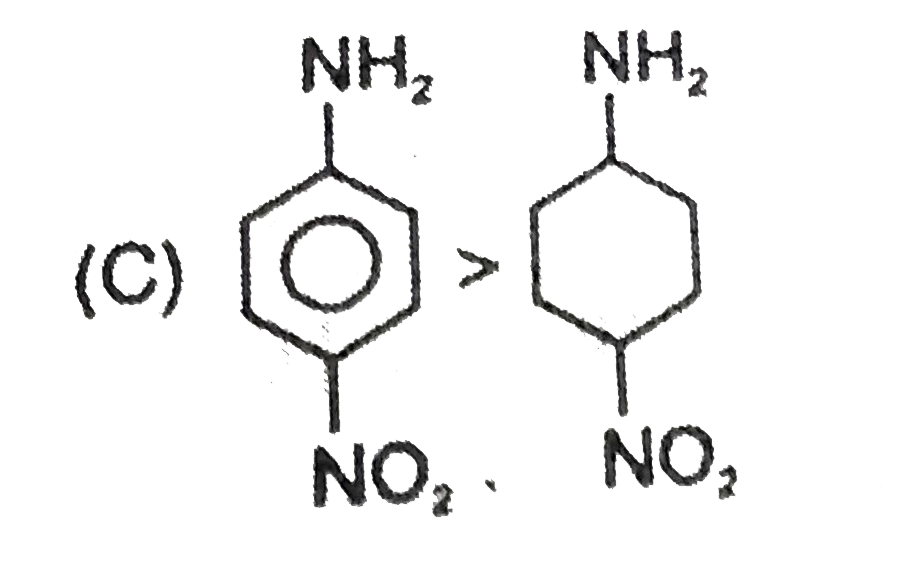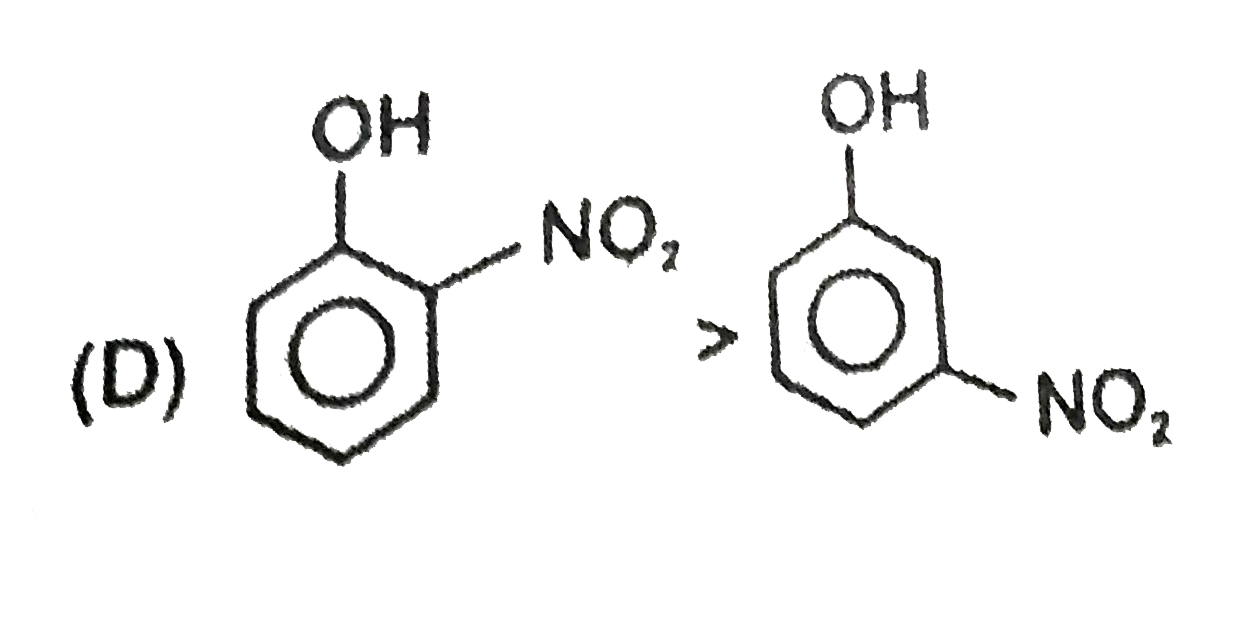The correct orders are:


 basicity order
basicity order
 acidity order
acidity order
The correct Answer is:A, B
To solve the question regarding the correct orders of acidity and basicity for the given compounds, we will analyze the structures and their effects on acidity and basicity step by step.
Step 1: Analyze the Structures
We have two main structures to consider:
1. Structure A: Contains a carboxylic acid group (COOH) with two methyl (CH3) groups at the ortho positions and a nitro (NO2) group at the para position.
2. Structure B: Contains a carboxylic acid group (COOH) with two nitro (NO2) groups at the meta positions and a hydroxyl (OH) group at the para position.
Step 2: Assess Acidity
To determine the acidity of these compounds, we need to consider the stability of the conjugate base formed after deprotonation (removal of H+).
- For Structure A: The presence of two bulky CH3 groups at the ortho positions creates steric hindrance, which affects the resonance stabilization of the negative charge on the conjugate base. The negative charge can be delocalized over the oxygen atoms, but the steric hindrance reduces the effective resonance stabilization.
- For Structure B: The nitro groups at the meta positions do not provide resonance stabilization to the conjugate base as effectively as the ortho groups in Structure A. However, the presence of the hydroxyl group can stabilize the negative charge through resonance.
Step 3: Compare Acidity
- The steric hindrance in Structure A reduces the resonance stabilization of the negative charge, making it less acidic compared to Structure B, where the negative charge can be more effectively stabilized by resonance with the hydroxyl group.
Conclusion on Acidity
Thus, the order of acidity is:
Acidity: A < B
Step 4: Assess Basicity
Now, let's consider the basicity of the compounds:
- Aromatic amines (like Structure A) have their lone pair of electrons involved in resonance with the aromatic ring, making them less available for protonation.
- Aliphatic amines (like Structure B) have their lone pair of electrons more available for donation since they are not involved in resonance.
Conclusion on Basicity
Therefore, the order of basicity is:
Basicity: Aliphatic amines > Aromatic amines
Final Answer
The correct orders are:
- Acidity: B>A
- Basicity: Aliphatic amines>Aromatic amines
We have two main structures to consider:
1. Structure A: Contains a carboxylic acid group (COOH) with two methyl (CH3) groups at the ortho positions and a nitro (NO2) group at the para position.
2. Structure B: Contains a carboxylic acid group (COOH) with two nitro (NO2) groups at the meta positions and a hydroxyl (OH) group at the para position.
To determine the acidity of these compounds, we need to consider the stability of the conjugate base formed after deprotonation (removal of H+).
- For Structure B: The nitro groups at the meta positions do not provide resonance stabilization to the conjugate base as effectively as the ortho groups in Structure A. However, the presence of the hydroxyl group can stabilize the negative charge through resonance.
- The steric hindrance in Structure A reduces the resonance stabilization of the negative charge, making it less acidic compared to Structure B, where the negative charge can be more effectively stabilized by resonance with the hydroxyl group.
Thus, the order of acidity is:
Acidity: A < B
Now, let's consider the basicity of the compounds:
- Aromatic amines (like Structure A) have their lone pair of electrons involved in resonance with the aromatic ring, making them less available for protonation.
- Aliphatic amines (like Structure B) have their lone pair of electrons more available for donation since they are not involved in resonance.
Therefore, the order of basicity is:
Basicity: Aliphatic amines > Aromatic amines
The correct orders are:
- Acidity: B>A
- Basicity: Aliphatic amines>Aromatic amines
Topper's Solved these Questions
- GENERAL ORGANIC CHEMISTRY IIBOOK - RESONANCE ENGLISHCHAPTER - GENERAL ORGANIC CHEMISTRY IIEXERCISE - Part-II: Single And Double Value Integer Type
9 Videos
- GENERAL ORGANIC CHEMISTRY IIBOOK - RESONANCE ENGLISHCHAPTER - GENERAL ORGANIC CHEMISTRY IIEXERCISE - Part-III: One or More Than One Options Correct Type
9 Videos
- GENERAL ORGANIC CHEMISTRY IIBOOK - RESONANCE ENGLISHCHAPTER - GENERAL ORGANIC CHEMISTRY IIEXERCISE - Part-III: Match the Column
2 Videos
- GASEOUS STATEBOOK - RESONANCE ENGLISHCHAPTER - GASEOUS STATEEXERCISE - ORGANIC CHEMISTRY(Hydrocarbon)
18 Videos
- GENERAL ORGANIC CHEMISTRY-IBOOK - RESONANCE ENGLISHCHAPTER - GENERAL ORGANIC CHEMISTRY-IEXERCISE - PART-III : PRACTICE TEST-19
1 Videos
Similar Questions
Knowledge Check
The correct order of reactivity in alkali metals is:
ALi>Na>KBNa>Li>KCK>Li>NaDK>Na>LiThe correct order of acidic strength is
AK2O>CaO>MgOBCO2>N2O5>SO3CNa2O>MgO>Al2O3DCl2O7>SO2>P4O10
The correct order of acid strength is
View SolutionThe correct order for bond angles is :
View SolutionThe correct order of vertebrae is
View SolutionThe correct order of atomic sizes is
View SolutionThe correct order of atomic sizes is
View SolutionThe correct order of electron affinity is :-
View Solution
